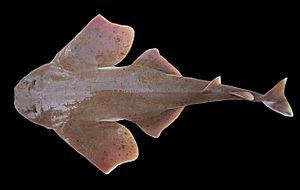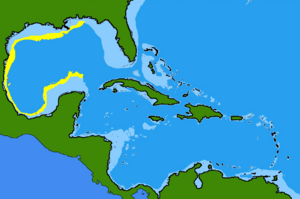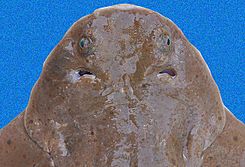Mexican angelshark facts for kids
Quick facts for kids Mexican angelshark |
|
|---|---|
 |
|
| Conservation status | |
| Scientific classification | |
| Genus: |
Squatina
|
| Species: |
mexicana
|
 |
|
The Mexican angelshark (Squatina mexicana) is a type of angelshark. It lives in the deep waters of the Gulf of Mexico. This shark can be found at depths between 70 and 180 meters (about 230 to 590 feet). It can grow to be about 88 centimeters (35 inches) long.
Contents
What is an Angelshark?
Angelsharks are unique sharks. They have flat bodies and wide pectoral fins. These fins look a bit like wings. This gives them their "angel" name. They also have two dorsal fins on their back. Angelsharks often look like rays or skates. However, they are true sharks. They have gills on the sides of their heads. Rays and skates have gills on their undersides.
How Angelsharks are Different
Angelsharks are different from most sharks. Most sharks swim constantly. Angelsharks spend most of their time on the seafloor. They are masters of camouflage. They can blend in perfectly with the sand or mud. This helps them hide from predators. It also helps them ambush their prey.
Where Does the Mexican Angelshark Live?
The Mexican angelshark lives in the Gulf of Mexico. This is a large body of water. It is partly surrounded by North America. The shark prefers deeper parts of the Gulf. It lives on the sandy or muddy bottom. This habitat provides good hiding spots. It also offers plenty of food.
Its Habitat and Environment
The seafloor where these sharks live is often dark. Sunlight does not reach these depths. The water temperature is also cooler. The Mexican angelshark is well-adapted to this environment. Its flat body helps it stay hidden. It can bury itself in the sediment. Only its eyes might stick out.
What Does the Mexican Angelshark Eat?
Like other angelsharks, the Mexican angelshark is a predator. It hunts for food on the seafloor. It mostly eats small fish. It also eats crustaceans. These include crabs and shrimp. Sometimes it might eat other small bottom-dwelling animals.
Hunting Strategy
The Mexican angelshark uses a special hunting method. It waits patiently on the seafloor. It stays perfectly still. When a fish or crustacean swims by, the shark acts fast. It lunges forward and grabs its prey. This surprise attack is very effective. Its wide mouth helps it catch food quickly.
How Big Are They?
The Mexican angelshark is a medium-sized shark. It can reach a length of about 88 centimeters. This is almost a meter long. To give you an idea, that's roughly the length of a baseball bat. Females might grow a bit larger than males. This is common in many shark species.
Size Compared to Other Sharks
Some sharks are much larger. For example, the whale shark is the biggest fish. It can be over 12 meters long. The Mexican angelshark is much smaller. But it is still a powerful predator in its habitat. Its size helps it fit into its environment. It can hide easily on the seafloor.
Life Cycle and Reproduction
Not much is known about the exact reproduction of the Mexican angelshark. However, most angelsharks are ovoviviparous. This means their eggs hatch inside the mother's body. The young sharks then develop inside her. They get nourishment from a yolk sac.
Birth and Young Sharks
When the young sharks are fully developed, they are born live. They look like miniature versions of the adults. They are ready to live on their own right away. This method of reproduction helps the young survive. They are born more developed and capable. The number of pups can vary. It depends on the specific angelshark species.
Conservation Status
The Mexican angelshark is currently listed as "Least Concern" (LC). This means its population is stable. It is not considered to be in danger of extinction right now. This status comes from the International Union for Conservation of Nature (IUCN). They assess the risk of extinction for species.
Why Conservation Matters
Even if a species is "Least Concern," it's important to protect its habitat. Pollution and fishing can affect all ocean animals. Learning about sharks like the Mexican angelshark helps us understand them better. This knowledge can help protect them for the future.
See also
- Angelshark
- Gulf of Mexico
- In Spanish: Squatina mexicana para niños




